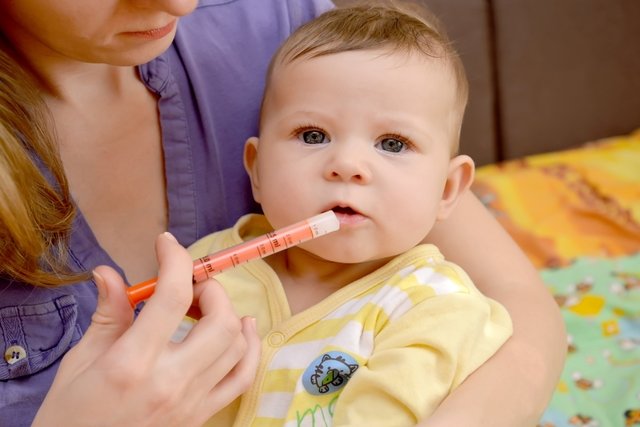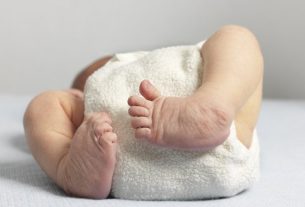When giving medicine to a baby, some care must be taken, such as making sure that the dose is correct using the doser provided in the packaging, checking whether the medicine is indicated for use by children, whether it is within the expiration date or whether or not it should be taken with food or liquids.
The way to give the medicine to the baby varies according to the type of medicine, whether it is syrup or drops to be used orally, eye drops to be applied to the eyes or drops to be applied to the ears, and in general, you should always wash hands before giving the medicine and placing the baby in a comfortable position.
Furthermore, it is important that medicines for babies are always recommended by a pediatrician, who must advise the correct dose according to the baby’s weight, the severity of the symptoms, the condition to be treated, as well as the duration of treatment.

How to give the medicine to the baby
The way to give the medicine to the baby varies according to the route of administration, that is, whether it is an oral medicine, or drops to apply to the ear or eyes.
Therefore, the main recommendations are:
1. Syrups or oral drops
Most medicines for babies are oral syrups or drops, which must be given into the baby’s mouth.
To give the syrup or oral drops, you must follow some steps:
- Wash your hands with soap and water and dry with a clean, dry cloth before preparing the dose;
- Shake the medicine bottleif it is a pediatric suspension, to mix the ingredients of the formula;
- Fit the dosing syringe to the bottle adapter and fill the syringe to the mL level indicated for the baby’s weight, if the dosing syringe was provided in the packaging;
- Use the measuring spoon or measuring cupto measure the correct amount of medicine in mL or the number of drops;
- Holding the baby on your lap, in an upright position, at least at a 45-degree angle, to avoid choking or choking. If the baby is already sitting up, you can place him/her in the baby seat;
- Place the tip of the dosing syringe gently into the baby’s mouth, and give the dose slowly, placing the medicine on the side of the mouth, between the gums and the inside of the cheek, to avoid choking. Never squirt the medicine down the back of the baby’s throat;
- Give some water for the baby to “wash” the mouth after giving the dose.
In the case of a measuring spoon or measuring cup, you can buy a children’s measuring syringe in pharmacies or drugstores, to extract the dose from the measuring cup or measuring cup, and give it to the baby.
After giving the dose to the baby, the dosing syringe, measuring spoon or measuring cup must be washed with warm water and neutral soap, and dried with a clean, dry cloth, such as a diaper, for example.
2. Eye drops
Eye drops are ophthalmological solutions or suspensions to be applied to the baby’s eyes.
To apply eye drops to your baby’s eye, you must:
- Wash your hands with soap and water, and dry well with a clean, dry cloth;
- Open the eye drop bottlewithout touching the tip of the bottle;
- Shake the eye drop bottlein the case of ophthalmological suspension;
- Hold the baby on your lapand you can wrap it in a blanket or blanket;
- Gently pull the lower eyelid downto form a pouch between the eyelid and the eye, using the thumb of one hand;
- With the other hand, apply the recommended amount of eye drops. on the lower part of the eyelid, being careful not to touch the bottle to the baby’s eye;
- Release the lower eyelidto allow the baby to blink;
- Externally clean the baby’s eye with a clean and dry sterile gauze, one for each eye, and discard them afterwards.
In the case of ophthalmic ointment, the same steps must be followed for eye drops, but instead of dripping drops of eye drops, approximately 1 cm of ophthalmic ointment must be applied to the pocket formed by pulling the lower eyelid downwards, taking Be careful not to touch the tip of the ointment tube to the baby’s eye.
Eye drops and ophthalmological ointments can generally be used for a specific time after opening, therefore, the leaflet must check the expiration date after opening, and at what temperature it should be stored, and write the date on the bottle and medicine box. after opening, and discard any unused quantity after this period.
3. Ear drops
Ear drops are medicines to be applied to the ear, in cases of ear infection, for example.
To apply ear drops to the baby’s ear, you must:
- Wash your hands with soap and water and dry well with a clean, dry cloth;
- Shake the medicine bottle to mix the formula ingredients;
- Hold the baby on your lapand you can wrap it in a blanket or blanket;
- Put the baby on the sidewith the ear facing upwards;
- Gently pull the baby’s earlobe backto allow the ear canal to be opened;
- Apply the amount of drops recommended by your pediatrician, inside the ear canal, being careful not to touch the tip of the bottle to the baby’s ear. It is important not to stick the bottle into the baby’s ear;
- Keep the baby in this position for a few minutes;
- Repeat the procedure for the other earif the treatment was indicated for both of the baby’s ears.
After applying the drops to the ear, the external ear must be cleaned with clean, dry sterile gauze to remove any amount of medicine that remains on the outside of the ear.
Thus, like eye drops and ophthalmic ointments, ear drops have a short shelf life after opening, and you should check the leaflet for how long they can be used after opening, note on the bottle and box, and after this period discard any unused quantity.
Care before giving medicine to your baby
Some precautions are important to ensure safety when giving the medicine to the baby, such as:
- Give only medicines recommended by your pediatricianand in the doses indicated by the doctor;
- Respect the duration of treatment indicated by your pediatricianespecially in the case of antibiotics, which should always be taken until the date advised by the doctor, even if the baby’s symptoms improve before the end of treatment;
- Avoid giving medicine yourselfincluding supplements, teas, natural or home remedies, as they may not be safe for the baby;
- Only use formulations suitable for use by childrenwhich usually says “pediatric use” or “children’s use”;
- Read the label on the medicine package and bottlebefore preparing the dose, to make sure that the right medicine will be given;
- Check the expiration date of the medicineso as not to give expired medicine to the baby;
- Check with your pediatrician whether the medicine can be given diluted in milk, water or juices;
- Ask your pediatrician whether the medicine should be given before or after feeding your baby.as some medicines must be taken on an empty stomach to have their effect;
- Check with your pediatrician about the side effects of the medicine;
- Note dose timesto ensure that you forget a dose, or give a repeated dose, and that is why it is recommended that you record the dose times on paper;
- Set an alarm to wake up when giving the dose of medicine to the baby;
- Use the dosing syringe, measuring spoon or measuring cupprovided in the packaging, to guarantee the correct dose;
- Do not force the baby to ingest the medicineas it may cause choking or suffocation.
In the case of treatments lasting several days, it is important to respect the duration of treatment indicated by the doctor, especially in the case of antibiotics, which must always be taken by the indicated date.
Furthermore, it is important to keep all medicines out of the reach of children, as they could be confused with sweets and the child could consume them by mistake. If this happens, it is important to take the child to the hospital as quickly as possible, also taking the medicine package with you.
What to do if the child vomits after taking the medicine
When the child vomits within 30 minutes after taking the medicine or whenever it is possible to observe the entire medicine in the child’s vomit, it is recommended to repeat the dose again, as the body has not yet had time to absorb it.
However, if the child vomits again or if vomiting occurs after half an hour, the medication should not be given again and the pediatrician who prescribed it should be contacted or consulted to find out what to do, as this varies depending on according to the type of medicine.

Sign up for our newsletter and stay up to date with exclusive news
that can transform your routine!
Warning: Undefined array key "title" in /home/storelat/public_html/wp-content/plugins/link-whisper-premium/templates/frontend/related-posts.php on line 12
Warning: Undefined array key "title_tag" in /home/storelat/public_html/wp-content/plugins/link-whisper-premium/templates/frontend/related-posts.php on line 13



